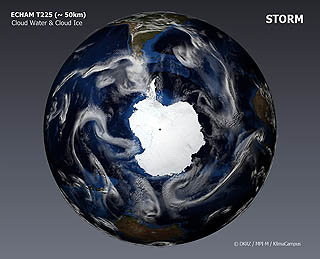The consortium project STORM was led by scientists from KlimaCampus. The atmosphere and ocean model components used within STORM are based on the latest version of the well-proven ECHAM atmosphere model and the MPIOM ocean model. The mean horizontal resolution of the atmosphere model is approximately 40 km (768 x 384 grid cells on a Gaussian Grid). With vertically 199 model levels, the computational grid has a total size of 59 Mio points.
Scientific Goals
- How will the climate and the climate sensitivity of the model be influenced by the resolved small scale features?
- Enhancements for regional climate model simulations: STORM's simulation results can be used as a basis for very detailed regional model simulations with even higher spatial resolution.
- The results of the STORM simulations can be used for a detailed analysis of the variability and changes of numerous climate variables. These might be valuable in particular for climate impact research, such as for the statistical evaluation of extreme events or floodings caused by extreme weather.
Results
 The visualization on the left side shows a snapshot of the simulated cloud water and cloud ice distribution in the southern hemisphere.
The visualization on the left side shows a snapshot of the simulated cloud water and cloud ice distribution in the southern hemisphere.
In order to allow for the proper simulation of mesoscale ocean eddies, the ocean model component, MPIOM TP6M, uses a setup with even much higher spatial resolution. With a horizontal grid spacing of 10 km, yielding 3602 x 2394 grid cells per layer, and vertically 80 model layers, the model equations need to be solved for a total of 690 Mio grid cells. A curvilinear tripolar grid was chosen to achieve an almost evenly spaced ocean grid.
The visualization below shows the oceanic flow field in 75 m depth, simulated with the ocean model MPIOM TP6M within the STORM project. The animation shows the development for 2 model years. The model has a horizontal resolution of approximately 10 km and vertically 80 model layers, yielding a total of nearly 700 Mio grid points on a tripolar curvilinear grid. The STORM ocean simulations utilize 1920 blizzard cores (i.e. 60 nodes with 32 cores) and approximately 1.3 TeraByte memory. 197 model days are simulated per day.
The visualization of the velocity at 75 m depth clearly shows the structure of the most important currents in the Northern Atlantic.
